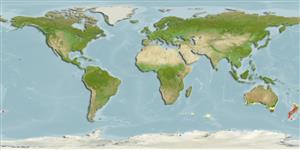Environment: milieu / climate zone / depth range / distribution range
Ecologie
marien demersaal; diepte 22 - 222 m (Ref. 58489), usually ? - 100 m (Ref. 30464). Temperate
Southwest Pacific: in temperate waters.
Grootte / Gewicht / Leeftijd
Maturity: Lm ? range ? - ? cm
Max length : 35.0 cm TL mannelijk / geslacht onbekend; (Ref. 30464); common length : 20.0 cm TL mannelijk / geslacht onbekend; (Ref. 30464)
Occur in the continental shelf (Ref. 7300, 75154). Benthic (Ref. 75154). Sedentary fishes that swim slowly and spend much of their time resting on the bottom. They use the long snout for probing in crevices, seaweed and sand for crabs, worms, and other benthic invertebrates (Ref. 30464). Neither anterolateral glandural groove nor venom gland is present (Ref. 57406).
Levenscyclus en paargedrag
Maturiteit | Voortplanting | Paaien | Eieren | Fecunditeit | Larven
Paxton, J.R., D.F. Hoese, G.R. Allen and J.E. Hanley, 1989. Pisces. Petromyzontidae to Carangidae. Zoological Catalogue of Australia, Vol. 7. Australian Government Publishing Service, Canberra, 665 p. (Ref. 7300)
Status op de Rode Lijst van het IUCN (Ref. 130435: Version 2024-2)
Gevaar voor de mens
Harmless
Gebruik door de mens
Visserij: van geen belang
Tools
Speciale rapporten
Download XML
Internetbronnen
Estimates based on models
Preferred temperature (Ref.
123201): 10 - 18.1, mean 15.1 °C (based on 157 cells).
Fylogenetische diversiteitsindex (Ref.
82804): PD
50 = 0.5176 [Uniqueness, from 0.5 = low to 2.0 = high].
Bayesian length-weight: a=0.01995 (0.00906 - 0.04395), b=3.01 (2.83 - 3.19), in cm total length, based on all LWR estimates for this body shape (Ref.
93245).
Trofisch niveau (Ref.
69278): 3.8 ±0.4 se; based on size and trophs of closest relatives
Fishing Vulnerability (Ref.
59153): Low vulnerability (25 of 100).
